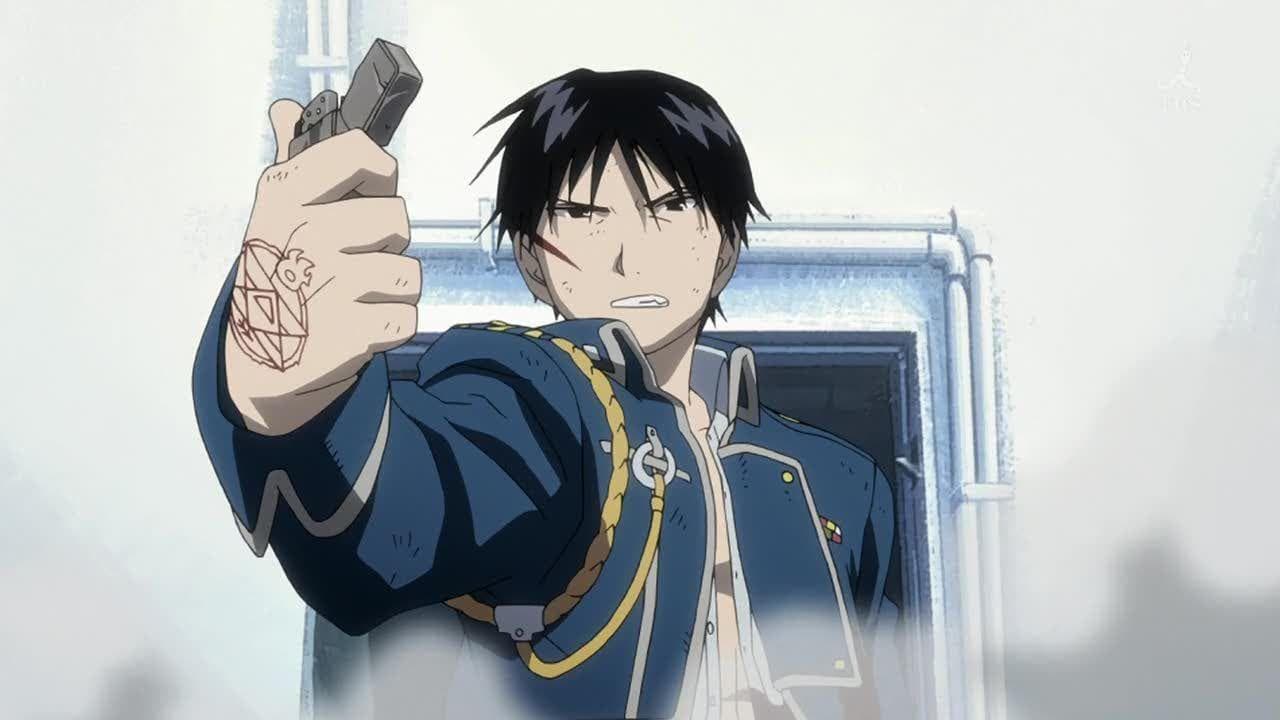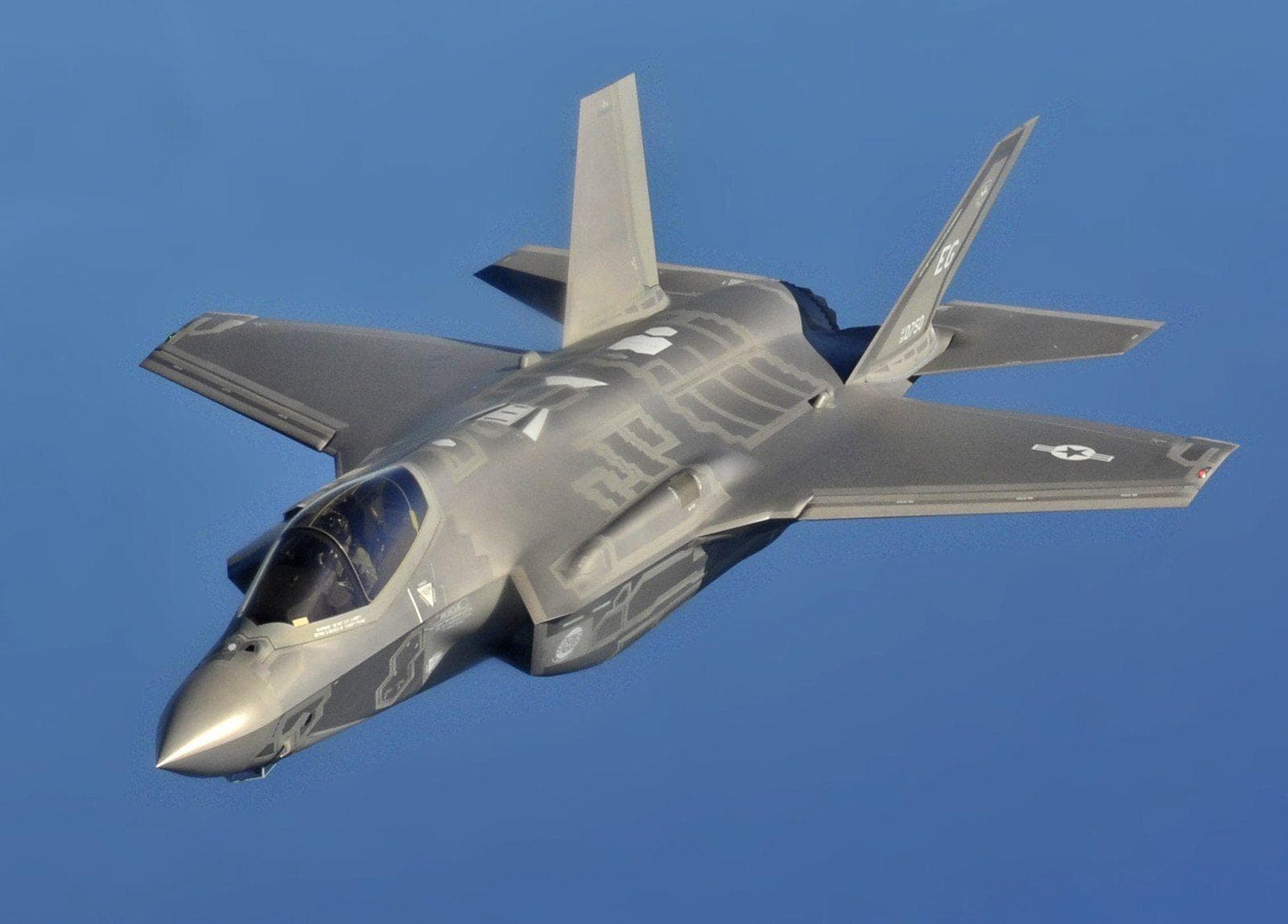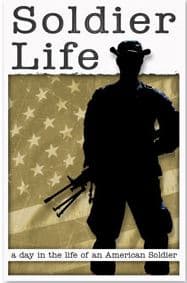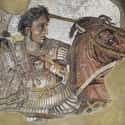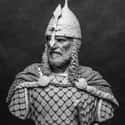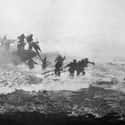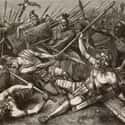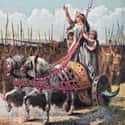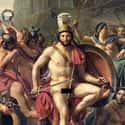-
(#3) Alexander the Great
- Dec. at 33 (355 BC-322 BC)
Where and When: As if his nickname weren’t enough indication, Alexander the Great is considered to be one of the very best military leaders in all of history. In just seven short years as King of Macedon from 336 to 323 BCE, Alexander went conquest-wild and earned himself a bunch of other titles like King of Persia, Pharaoh of Egypt, and Lord of Asia. In anticlimactic fashion, however, he perished on his way home by either natural causes or poison.
The Arsenal: Alexander’s father, Philip II, refurbished the Macedonian army before handing it off to his son. Under his reign, infantry started to carry an enormous sarissa, a 22-foot pike with an iron tip that could be used to take down charging cavalry with ease. Alexander is alternately depicted wielding either a spear on horseback or a much shorter sword, but he’s always shown in shining armor.
His Training: Of all the legendary leaders of antiquity, Alexander the Great probably had the best education. He was personally tutored by Aristotle throughout his youth in everything but the art of warfare, which he learned directly from his father. While much of the focus would have been on strategy, it’s also obvious that Alexander was brought up to be an excellent fighter.
In The Duel: The most famous swing of Alexander’s sword was at an inanimate object, the Gordian Knot, but that doesn’t mean he wasn’t capable on the battlefield. In combat against the Persian Empire, he led his Royal Companion Cavalry charging right into the heart of the enemy. In one particular incident, Alexander was said to have caught up to Darius’ fleeing chariot and dispatched the driver, only for Darius to escape his clutches. If Alexander is showing up at a fight, he’s doing so on horseback, and with a brilliant strategy already in mind to defeat his opponent.
-
(#10) Saladin
Where and When: Saladin was one of the greatest heroes during the Crusades era, thanks to some rather impressive victories on his resume. Ruling over modern Egypt, Syria, Yemen, and Palestine from 1169 until his passing in 1193, Ṣalāḥ al-Dīn Yūsuf ibn Ayyūb won renown for capturing Jerusalem from the Franks and from fighting Richard the Lion-Heart to a difficult draw in the Third Crusade.
The Arsenal: Saladin was known to wield a large scimitar in battle, and he wasn’t afraid to use it. On one occasion, he is said to have personally cut the head off a notorious French crusader. Anything else is secondary when one has a big sword in their hands and is willing to swing it head-high.
His Training: From a young age, Saladin took mentorship from brilliant military minds, including the famous anti-crusader Nur al-Din and Shirkuh, his uncle. They would have personally trained him in both combat and strategy, lessons that he carried with him in his own rise to prominence.
In The Duel: Saladin could be brutal when necessary and engaged in his fair share of executions, but he was also wise enough to avoid violence for violence’s sake. One of his battlefield trademarks was his remarkable willingness to put himself at risk, charging into battle without any care for his own life, but that could either pay off or backfire horribly in a duel with other, perhaps more cautious, historical figures.
-
(#8) Jack Churchill
- Dec. at 90 (1906-1996)
Where and When: Unlike most of the other famous swordfighters in history, Fighting Jack Churchill stuck around well into the modern age - living from 1906 to 1996. In the interim, Churchill became a WWII legend for the British army, both because of the courage he always brought to the field.
The Arsenal: As a member of the British infantry, Churchill would have been outfitted with the standard uniform and weaponry, but he also brought his own fun to the party. Churchill marched into battle playing his bagpipe, with a traditional English longbow strapped to his back and an enormous Scottish claybeg sword at his side.
His Training: Rising through the British officer ranks, Churchill received a great deal of training from early adulthood onward; so much so that he was already well versed in martial matters by the time WWII broke out. His skill with a bow and sword, however, must have been the result of his upbringing, because it’s not something he would have learned in the army.
In The Duel: Churchill is believed to have slain at least one person with his longbow and engaged in sword combat on a number of occasions, including one incident in which he captured 42 Germans at sword-point. The fact that he was doing all this in the era of the machine gun is a true testament to the insane amount of bravery he would bring to a hypothetical duel, though some sort of rule would have to be created to prevent him from whipping out a gun at some point and blasting away at the others.
-
(#2) Spartacus
- Dec. at 38 (108 BC-70 BC)
Where and When: Spartacus was born in Thrace sometime around 100 BCE, but he didn’t stay there long, joining the Roman auxiliary as a young man before eventually deserting. This led to him being captured, enslaved, and sent to the gladiatorial pits. From there, Spartacus organized a slave revolt that eventually swelled to tens of thousands, defeating the Romans a handful of times before perishing in battle in 71 BCE.
The Arsenal: Spartacus himself and those other members of his rebellion to come from the gladiatorial pits would have had access to any number of weapons, including gladius swords, wooden shields, and leather armor. As a Thracian specifically, Spartacus would have used a parmula shield and a short sica sword, angled at the end.
His Training: Spartacus should have been an exceptionally well-trained individual. Not only did he grow up in the militaristic society of Thrace, but he was also trained as a member of the Roman auxiliary. Then after all that, he went to one of Rome’s famous “gladiator schools,” where he learned all manner of one-on-one combat.
In The Duel: Unlike most of the other great military leaders in history who typically only fought at the head of an army, Spartacus had plenty of experience facing solo opponents as a gladiator, which should serve him well in any hypothetical duel. His legendary ability to inspire others wouldn’t serve him well, but his craftiness and ability to adapt - as well as his willingness to fight dirty - would.
-
(#9) Boudica
Where and When: As far as origin stories go, Queen Boudica of the Iceni’s sounds like something out of a comic book. Her husband, Prasutagus, was betrayed by the Romans and slain. Then, Boudica was publicly flogged and her daughters were raped. Rather than be defeated, she instead allied herself with a handful of other Celtic tribes in rebellion against the empire. Boudica led her army all the way to Londinium and burned it to the ground. When Suetonius and the Romans returned in full force, her troops were routed, and Boudica decided to take her own life rather than be captured in 61 CE.
The Arsenal: Boudica led from the back of a horse-drawn cart, which combined with her hip-length hair and unusual height made for an intimidating figure. She and her forces mostly carried long spears, though they had swords, as well. Julius Caesar claimed that Boudica and her allies went into battle naked and dyed blue, which may not be entirely true, but suffice it to say that their armor was lacking.
Her Training: Boudica’s rebellious troops were said to be equally filled with men and women, and so it stands to reason that martial training of some sort was an aspect of a young girl’s life in the Iceni tribe including Boudica’s. Unfortunately, no specifics are known.
In The Duel: Boudica is most famous for riding around in a chariot with her daughters before her final fight, taunting her enemies and rousing her allies, but she also rode that chariot directly into the fight. Even in a route, she evaded capture long enough to take a fatal poison, so one can assume that she was a rather competent driver. Anyone expecting mercy from Boudica will be unpleasantly surprised, as the atrocities committed in her name will attest to. She will fight with righteous fury, and nothing else, but that can only take a person so far.
-
(#5) Leonidas I
- Dec. at 60 (539 BC-479 BC)
Where and When: Well-known by most as the central figure of the Battle of Thermopylae in 480 BCE (of 300 fame,) King Leonidas of Sparta led his city-state through a bloody 10-year reign. His primary mission in life was to halt the Persian invasion of Ancient Greece, which he ultimately did, though he gave up his life to do it.
The Arsenal: As part of a Spartan phalanx, Leonidas had no need for his own special set of equipment. In fact, it would have been counterproductive if he did. Spartan strategy revolved around every warrior having the same set of round shield, long spear, and short sword, which they then employed in a tight formation to overwhelm their enemies. Armor was secondary, though it certainly wasn’t as sparse as it appears in Hollywood adaptations.
His Training: Leonidas’ older half-brother was the heir to the throne of Sparta, and so young Leonidas entered into Hoplite training like any other Spartan commoner would have. This meant that the military culture of Sparta was fully ingrained in him and that he learned how to command a phalanx, the tactical trademark of the city-state.
In The Duel: King Leonidas might be in some trouble when it comes to a series of duels with other historical figures. Though he was undoubtedly a powerful fighter, he was used to working as part of a phalanx, and thus relied entirely on the support and positioning of his comrades to be effective in battle. If one takes a Spartan out of the phalanx, it should dramatically reduce their effectiveness, making Leonidas just another tough guy in a field that’s crawling with them.
New Random Displays Display All By Ranking
About This Tool
In ancient history, many great politicians, thinkers, artists, and scientists have emerged, among which many outstanding military strategists and generals have appeared and remembered. Unlike the legendary warriors most people know, some heroes in history have lost their lives for the sake of war, even if they are defeated, their heroic deeds have been recited by generations to come.
In different human civilizations, there are many great historical figures in various fields, but no one has shed more blood than the greatest warrior in history. The random tool introduced the 16 strongest legendary warriors, we can learn their stories in different legends or history books.
Our data comes from Ranker, If you want to participate in the ranking of items displayed on this page, please click here.

